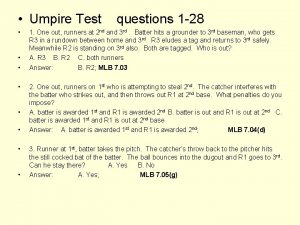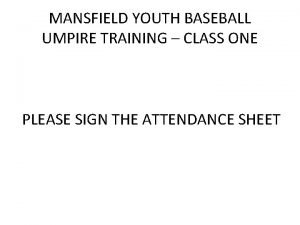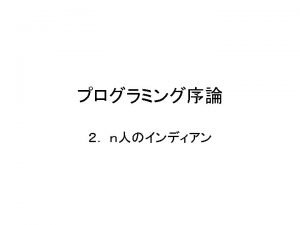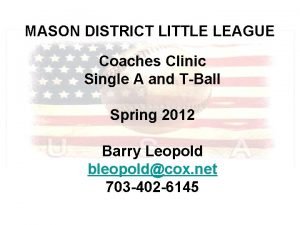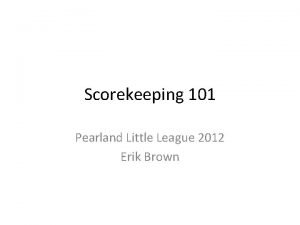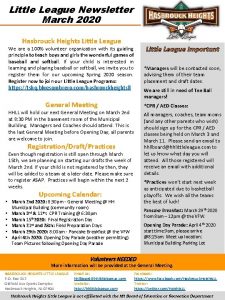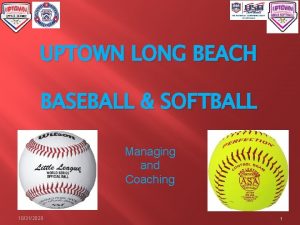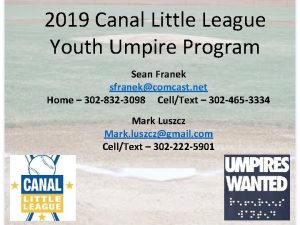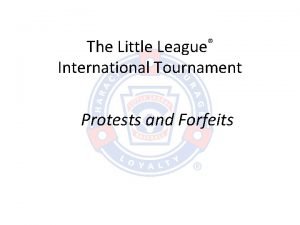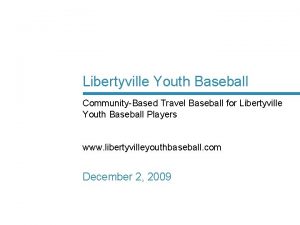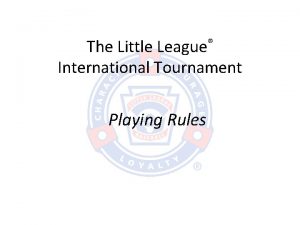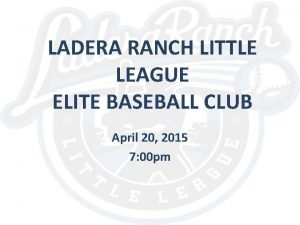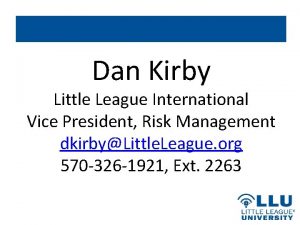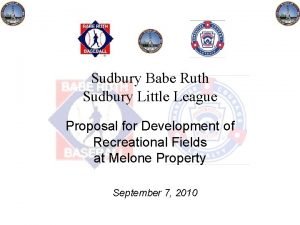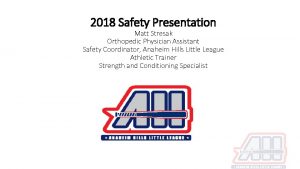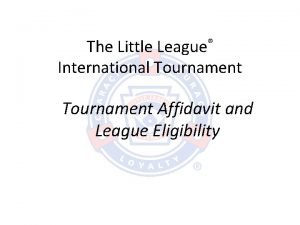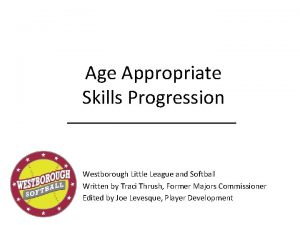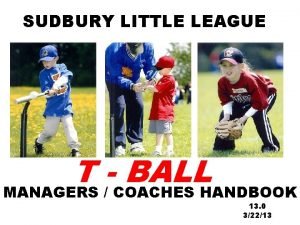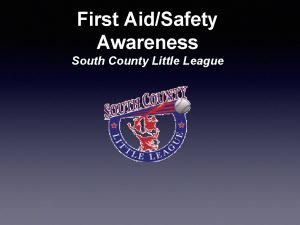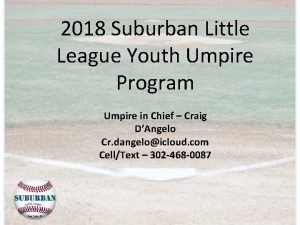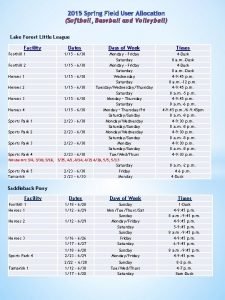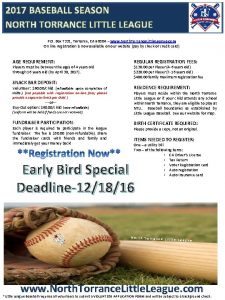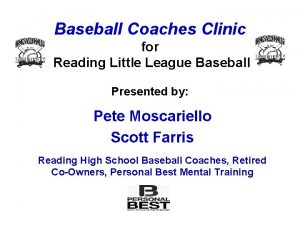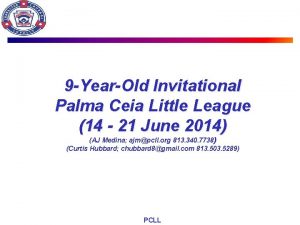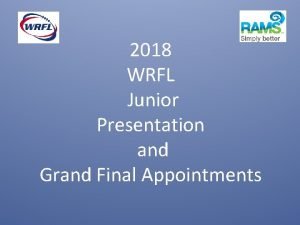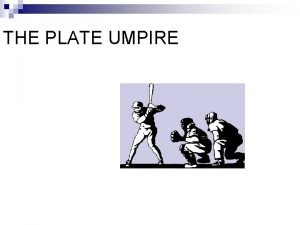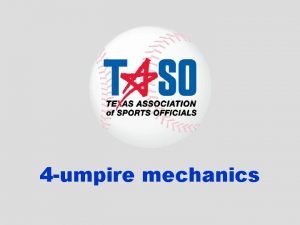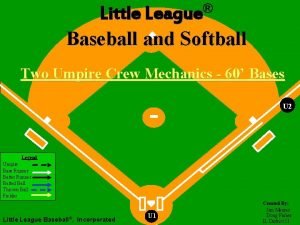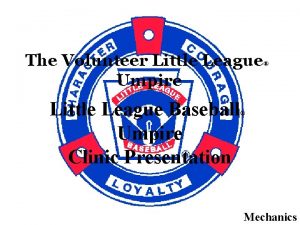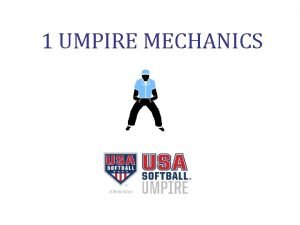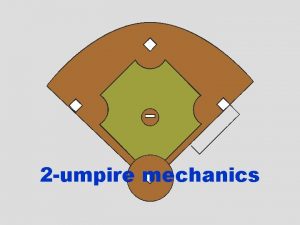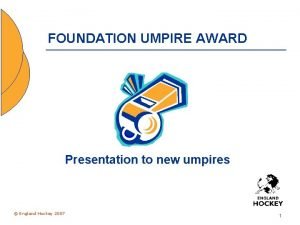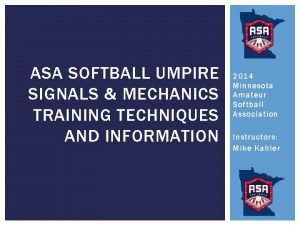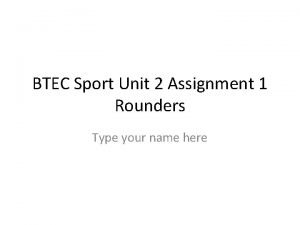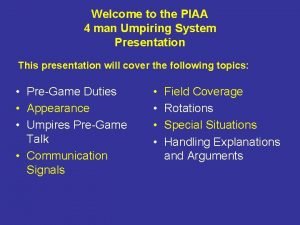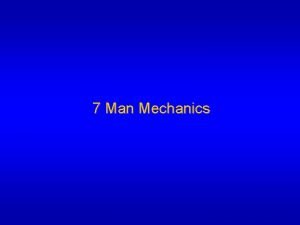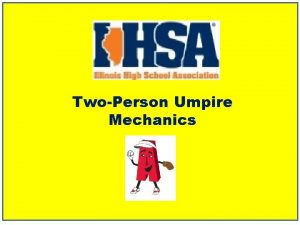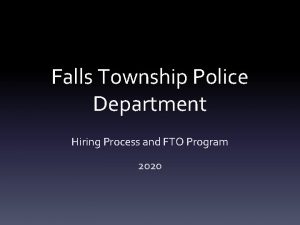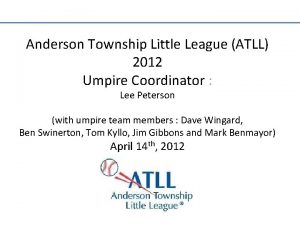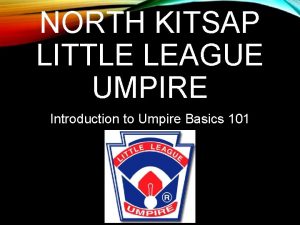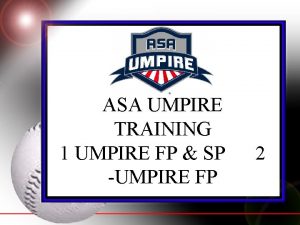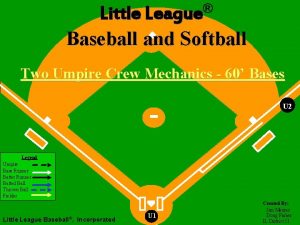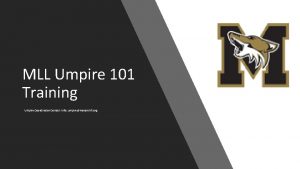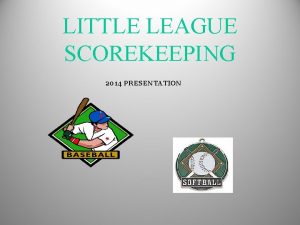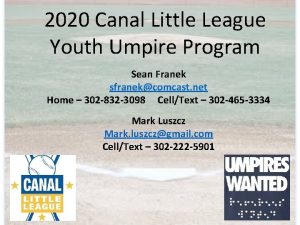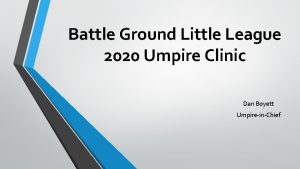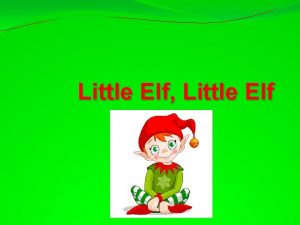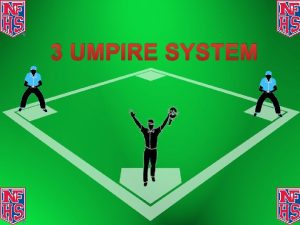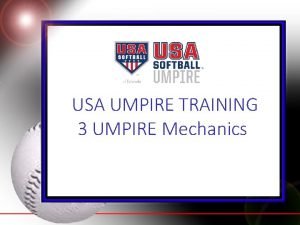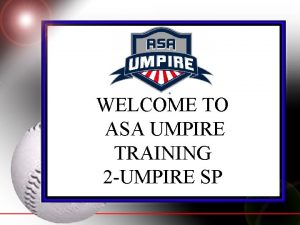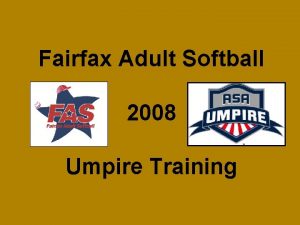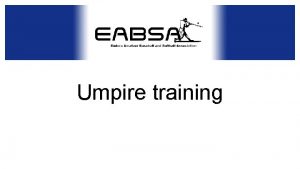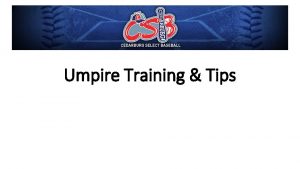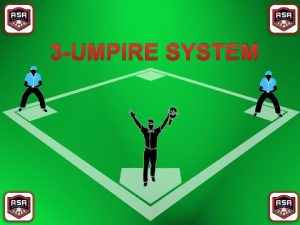Anderson Township Little League ATLL 2013 Umpire Coordinator




















































- Slides: 52

Anderson Township Little League (ATLL) 2013 Umpire Coordinator Lee Peterson (with Dave Wingard & Ben Swinerton) August 13 th, 2013

Agenda -The basics -Live Drills -Rules Review & Questions -Safety Update and Changes

The Plate Meeting q. Time / Length of Game, including Mercy Rule q. Field Boundaries q. Misc q. Jewelry q. On Deck Circle q. Hustle On / Hustle Off

Umpire Hand Calls q Safe / Out q Ball / Strike q Fair / Foul q Misc: q Infield Fly q Off the Bag q Juggling the Ball q Foul Tip q Giving the Count

Umpire Hand Calls

Umpire Hand Signals q Infield Fly situation (0 or 1 out) q Forgetting the Count or Outs q Good Call q Pre-Game Conference to discuss signals and situations q Arrive 15 minutes before game

Who’s on First? Who’s Abbott and Who’s Castello? Don’t want 2 umpires covering the same play 1 Play = 1 Umpire Plate Umpire – Home Base Umpire – 1 B, 2 B, and 3 B

Getting into the best Position

Asking for Help q Leave your ego at home q Umpire out of position can get help if they ask for it. q Make the call. If the other umpire sees something different, huddle up and talk about it. q Ultimately, it’s the original umpire’s call. q. Create credibility for yourself q. Mistakes happen q Example: First Basemen pulls his foot off the bag

Plate Basics q Positioning behind the catcher q. Box stance (heel-to-toe) q. Scissors q. Kneeling

Plate Basics q Positioning behind the catcher q. Chin no lower than the top of the catcher’s head q. Get into “The Slot” q. Turn head toward the glove slightly


Calling Strikes / Balls and Safe / Out • See It • Say It (to yourself) • Call It

section 2. 00 Definition of Strike – Part B A strike is a legal pitch that is not struck at when any part of the ball passes through any part of the strike zone.

section 2. 00 The strike zone is the space over home plate that is between the batter’s armpits and the top of the knees when the batter assumes a natural stance. The umpire shall determine the strike zone according to the batter’s usual stance when that batter swings at a pitch.

Foul Tip Section 2. 00 A foul tip is a batted ball that • Is sharp and direct from the bat to the catcher’s hand or mitt • Must be caught by the catcher § not a catch if it is caught on a rebound unless it first hits the catcher’s hand or mitt • Is a strike • Ball remains alive

Catch / No Catch Field umpire has responsibility for fly balls Field umpire can drift toward the side of the field the ball is on, but shouldn’t leave the diamond. Plate umpire covers bases temporarily (for tagging-up purposes) Signals: Catch = Out signal and say “catch” No Catch = Finger pointing on ground. Don’t verbalize.

DEFINITION OF CATCH • Secure possession • Complete control of the ball • Voluntary release of the ball CATCH – if the ball is dropped in the act of throwing. NO CATCH – if the ball is dropped as a result of a collision or falling or if the ball touches an offensive player, the ground or fence, or an umpire.

Definition of Fair Ball q A fair ball is a batted ball that: q. Settles or is touched on or over fair territory between home and 1 B or home and 3 B q. Bounds past 1 B or 3 B on or over fair territory q. While on or over fair territory touches the attached equipment or clothing of a player or umpire q. While over fair territory, passes out of the playing field

FAIR / FOUL Quiz 1 q A batted ball settles on home plate. What is your call? FAIR or FOUL

FAIR / FOUL Quiz 2 q A batted ball first hits foul ground and without touching any foreign object, rolls into fair territory between 1 B and home where it comes to rest. What is your call? FAIR

FAIR / FOUL Quiz 3 FAIR

Reducing the Margin of Error q Positioning + Timing = Good Judgment q Angle First, Then Distance q. If you have to, sacrifice distance for angle q Get Set – Be stopped for all plays q Watch the ball, Glance at the Runners q Timing q Hustle

Set Position q. Lower your seat; don’t just bend over q. Place hands on knees or thighs q. Keep your head up; don’t drop your chin q Getting Set q. Set position assumed BEFORE every pitch q. Set position assumed BEFORE calling most plays q. May be situations that mandate a standing “set”

Set Position

Umpire Field Positions

Position A

Position B

Position C

Number of pitches League age: 7 -8 9 -10 11 -12 13 -16 17 -18 = = = 50 pitches per day 75 pitches per day 85 pitches per day 95 pitches per day 105 pitches per day A pitcher who delivers 41 or more pitches in a game cannot play the position of catcher for the remainder of the game.

Legal Bats • Check bats before the pre-meeting • For 2 -1/4 diameter, they can be Aluminum, Metal alloy or Composite. They MUST have an "approved for little league" decal on them. • For 2 -5/8, Composite bats must BBCOR. All bats for this diameter must be "Minus 3“. No “approved for little league” decal is required.

IMPORTANT CARRY YOUR RULE BOOK IT IS BETTER TO CONSULT THE RULES AND HOLD UP THE GAME LONG ENOUGH TO DECIDE A KNOTTY PROBLEM THAN TO HAVE A GAME PROTESTED AND POSSIBLY REPLAYED. 2011 Official Regulations and Playing Rules p. 95

BATTING OUT OF TURN Rule 6. 07 3 scenarios q. While Incorrect batter is up - Correct the batter and resume the count. q. Immediately after the Incorrect batter reaches base – Batter is ruled out. q. A pitch or more after the Incorrect batter reaches base – Permanent Line-up Change.

Infield Fly Rules 2. 00, 6. 05 d, and 7. 08 f q Rule is to protect the offensive team q. But most often argued by the offensive manager q Must be less than 2 outs q Not a line drive or a bunt q Can be caught by any fielder “around the diamond” by ordinary effort q Runners on 1 B and 2 B or bases loaded

Infield Fly Rules 2. 00, 6. 05 d, and 7. 08 f q Umpire declares batted ball to be an infield fly q Batter-runner is called out q. Eliminates all force plays q. Base protects the runner hit by an infield fly (but not in non-infield-fly situations) q Must be fair q If the umpire is unsure, yell “If Fair, Infield Fly, Batter’s Out”

Infield Fly Rule – 2 scenarios q If caught, play on as a normal situation q If dropped, it’s like a “steal” situation. q. Runners may advanced, but they’re not forced q. The batter is not in the play (he is out)

Infield Fly Rule q Important Notes – Rule 7. 08(f): q. If a runner is touched by an Infield Fly when not touching a base, both runner and batter are out. q. If a runner is touching a base when touched by an Infield Fly, that runner is not out, although the batter is out. q. However, in a non-infield-fly situation, base does not protect the runner on a fair ball.

Offensive Interference q An act by a member of the team at bat which interferes with, obstructs, impedes, hinders, or confuses any fielder attempting to make a play q. Running into a fielder trying to make a catch q. Yelling at a fielder trying to make a catch

Umpire Interference Rules 5. 09(b), 5. 09(f), 6. 08(d) q Only 2 ways q. Interference with catcher’s throw qdelayed dead ball qbenefits the defensive team q. Umpire hit by a batted ball before passing a fielder qimmediately call a dead ball qbenefits the offensive team

Catcher’s Interference q The catcher or any fielder interferes with the batter q No interference call when the batter reaches first base AND all other runners advance at least one base qdelayed call by umpire

Obstruction Rule 7. 06 (a) and 7. 06(b) q Fielder’s Obstruction: q When fielder is not making a play on the ball, the runner has the right to the base-path. q Delayed Dead Ball q Runner’s Obstruction: q The fielder has the right to the ball, trumping the runner’s right to the base-path. q Dead Ball, Runner is Out, Batter and runners do not advance

Dead Ball Runners Return q Foul ball not caught – Rule 5. 09(e) q Illegally batted ball – Rule 5. 09(d) § foot out of the batter’s box at the point of contact q Plate umpire interference unless runner is thrown out – Rule 5. 09(b) q Batter interference of the catcher unless runner is thrown out – Rule 6. 06(c) § if base runner is safe, return to the previous base q Batter called out for batting out of turn – Rule 6. 07(b)

Dead Ball 1 base awarded q Runner attempting to steal when catcher’s interference occurs – Rule 7. 04(c) § batter also is award 1 B q Pitched ball lodges in umpire’s mask or equipment - Rule 5. 09(g) and 7. 05(h) q Pitched or thrown ball by the pitcher from the rubber goes into dead territory - Rule 7. 05(g) § pickoff – ball goes into bleachers § ball stuck in backstop or fence § ball goes into the dugout q Balk

Dead Ball 1 base awarded q After catching a fly ball, the fielder falls into dead territory – Rule 7. 04(b) § dugout § stands § over a fence into dead territory q Hit batsman – Rule 5. 09(a) q Fair batted ball strikes an umpire – Rule 5. 09(f)

Dead Ball 2 Bases Awarded from Time of Pitch q Thrown ball into dead territory on first play by an infielder – Rule 7. 05(g) q Fielder deflects a wild pitch into dead territory while retrieving it – Rule 7. 05(f) q Fair ball bounces over the fence – Rule 7. 05(f) q Fair ball is deflected into dead territory

Dead Ball 2 Bases Awarded from Time of Throw Rule 7. 05(g) q Thrown ball into dead territory on 2 nd play by an infielder § attempting a double play q Thrown ball into dead territory by an outfielder q Any relay throw into dead territory by any fielder

3 Bases Awarded q If a fielder deliberately touches a fair ball with a cap, mask or any part of that fielder’s uniform detached from its proper place on the person of said fielder, three bases are awarded and the ball is in play. – Rule 7. 05(b) q Each runner including the batter-runner may advance three bases if a fielder deliberately throws a glove at and touches a fair ball; the ball remains in play. – Rule 7. 05(c)

Delayed Dead Ball Situations q Catcher’s interference followed by a batted ball – Rule 6. 08(c) q Batter’s interference followed by a play or throw – Rule 6. 06(c) q Plate umpire interference followed by a play or throw –Rule 5. 09(b)

Appeals Rule 9. 02 b q If there is reasonable doubt that any umpire’s decision may be in conflict with the rules, the manager may appeal the decision and ask that a correct ruling be made. q Such appeal shall be made only to the umpire who made the protested decision. q Must be made before the next pitch, play, or attempted play q Must be a live ball for appeals to be made q Must be made before the defensive team leaves the field

Appeals Types of Appealed Plays q Failure to retouch properly – Rule 7. 10(a) q Missed base – Rule 7. 10(b) q Batting out of order – Rule 6. 07

Remember who it’s all about!!!

Questions Direct questions to the following email addresses: q. General ATLL Umpire (scheduling): andersontownshipumpire@gmail. com q. Dave Wingard Jr. : wingard. dave@gmail. com q. Ben Swinerton: benman 120@aol. com q. For other questions related to ATLL umpiring opportunities (such as volunteering), contact Lee Peterson: mleepeterson@gmail. com
 Little league umpire test answers
Little league umpire test answers Youth umpire pants
Youth umpire pants 1 little 2 little 3 little indian
1 little 2 little 3 little indian 1 little 2 little 3 little indian
1 little 2 little 3 little indian North mason little league
North mason little league Little league scorebook
Little league scorebook Hasbrouck heights little league
Hasbrouck heights little league Hasbrouck heights little league
Hasbrouck heights little league Uptown long beach baseball
Uptown long beach baseball Canal little league
Canal little league Little league protest
Little league protest Coaches meeting
Coaches meeting Libertyville travel baseball
Libertyville travel baseball Little league international rules
Little league international rules Ladera ranch little league
Ladera ranch little league Datacenter little league
Datacenter little league Sudbury little league
Sudbury little league Little league shoulder pain location
Little league shoulder pain location Little league affidavit
Little league affidavit Victor little league
Victor little league Westborough little league
Westborough little league Sudbury little league
Sudbury little league South county little league
South county little league Suburban little league
Suburban little league Newton little league
Newton little league Lake forest little league
Lake forest little league Sunset little league rio rancho
Sunset little league rio rancho Sunset little league rio rancho
Sunset little league rio rancho North torrance little league
North torrance little league Tracy little league
Tracy little league Reading little league
Reading little league Palma ceia little league
Palma ceia little league Wrfl umpire appointments
Wrfl umpire appointments Umpire slot position
Umpire slot position Umpire positions
Umpire positions 3 man umpire mechanics softball
3 man umpire mechanics softball Umpire slot position
Umpire slot position Baseball umpire mechanics
Baseball umpire mechanics Field umpire signals
Field umpire signals Gaa umpire signals
Gaa umpire signals 3 man umpire mechanics softball
3 man umpire mechanics softball 3 man umpire mechanics
3 man umpire mechanics Rounders umpire
Rounders umpire Piaa umpire
Piaa umpire 7 man mechanics
7 man mechanics Lone star softball umpires
Lone star softball umpires Plate umpire mechanics
Plate umpire mechanics Police defensive tactics
Police defensive tactics Howell township municipal
Howell township municipal Pa state association of township supervisors
Pa state association of township supervisors Neptune township school
Neptune township school Unit 1 ap human geography
Unit 1 ap human geography Brick township landfill
Brick township landfill
